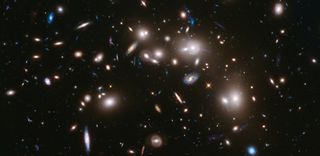
Why Is Hydrogen the Most Common Element in the Universe?

This story was updated April 4 at 12:24 p.m. EDT.
Hydrogen is the most common element in the universe, but why is that?
To answer this question, "we need to go back to the Big Bang," said May Nyman, a professor of chemistry at Oregon State University.
The Big Bang created the elements on the periodic table, building blocks that help make up the universe. Each element has a unique number of subatomic particles: protons (positively charged), neutrons (neutral) and electrons (negatively charged). [What Are the Ingredients of Life?]
Hydrogen — with just one proton and one electron (it's the only element without a neutron) — is the simplest element in the universe, which explains why it's also the most abundant, Nyman said. (However, an isotope of hydrogen, called deuterium, contains one protron and one neutron, and another, known as tritium, has one proton and two neutrons.)
In stars, hydrogen atoms fuse to create helium — the second most common element in the universe, according to Encyclopedia.com. Helium has two protons, two neutrons and two electrons. Together, helium and hydrogen make up 99.9 percent of known matter in the universe, according to Encyclopedia.com.
Even so, there is still about 10 times more hydrogen than helium in the universe, Nyman said. Oxygen, the third most common element, is about 1,000 times less abundant than hydrogen, she added.
Sign up for the Live Science daily newsletter now
Get the world’s most fascinating discoveries delivered straight to your inbox.
In general, the higher the atomic number, the less abundant is the element is, Nyman said.
Earth's composition, however, is different from that of the entire universe. For instance, oxygen is the most common element by weight in Earth's crust, followed by silicon, aluminum and iron, according to HyperPhysics, a site run by Georgia State University.
In the human body, the most common element by weight is oxygen, followed by carbon and hydrogen, according to HyperPhysics.
Hydrogen has a number of key roles in the human body. Hydrogen bonds help give DNA its signature twist, and it helps the stomach and other organs maintain the correct pH, or how acidic or basic it is, Nyman said.
"If your stomach gets too basic, hydrogen will be released to what it's bonded to," she said. "If it's too acidic, [hydrogen] will bond to something."
In addition, hydrogen allows ice to float on water (H20) because the hydrogen bonds push the frozen water molecules apart, making them less dense.
"Usually, substances are more dense when they're solid than when they're liquid," Nyman said. "Water is the only substance that is less dense than when it's [a] solid."
However, hydrogen can also be dangerous. Hydrogen gas reacting with oxygen led to the Hindenburg blimp catastrophe that killed 36 people in 1937, according to Airships.net. Moreover, hydrogen bombs can be incredibly destructive, although they have never been used as a weapon, "just demonstrated by the United States, USSR, Great Britain, France and China in the 1950s," Nyman said.
Hydrogen bombs, like atomic bombs, use a combination of nuclear fusion and fission reactions to cause destruction, and release both radiation and mechanical shock waves when detonated, she said.
Editor's Note: This article has been updated to include information about hydrogen isotopes and to say that H-bombs can release radiation.
Original article on Live Science.

Laura is the archaeology and Life's Little Mysteries editor at Live Science. She also reports on general science, including paleontology. Her work has appeared in The New York Times, Scholastic, Popular Science and Spectrum, a site on autism research. She has won multiple awards from the Society of Professional Journalists and the Washington Newspaper Publishers Association for her reporting at a weekly newspaper near Seattle. Laura holds a bachelor's degree in English literature and psychology from Washington University in St. Louis and a master's degree in science writing from NYU.
Most Popular

